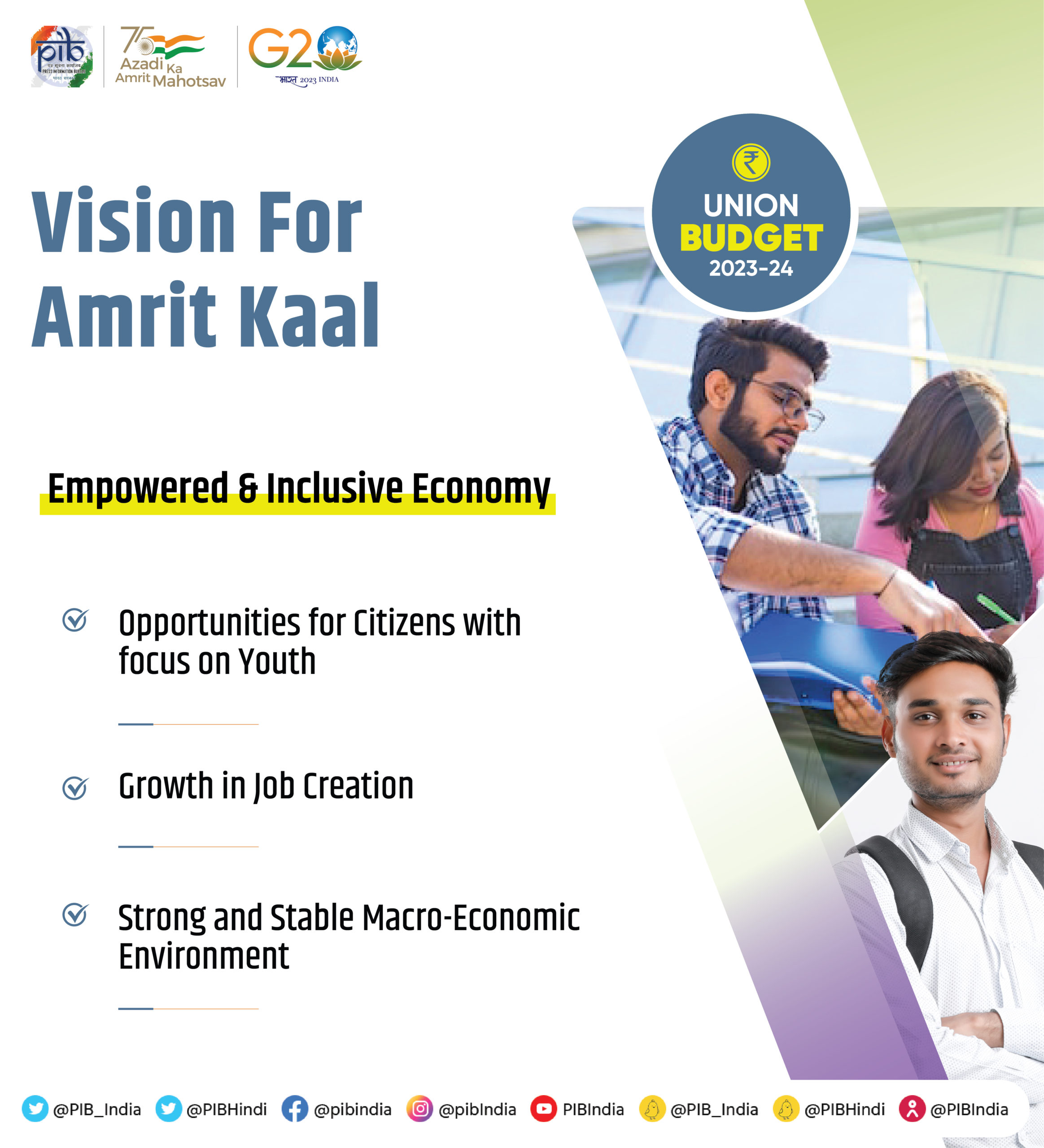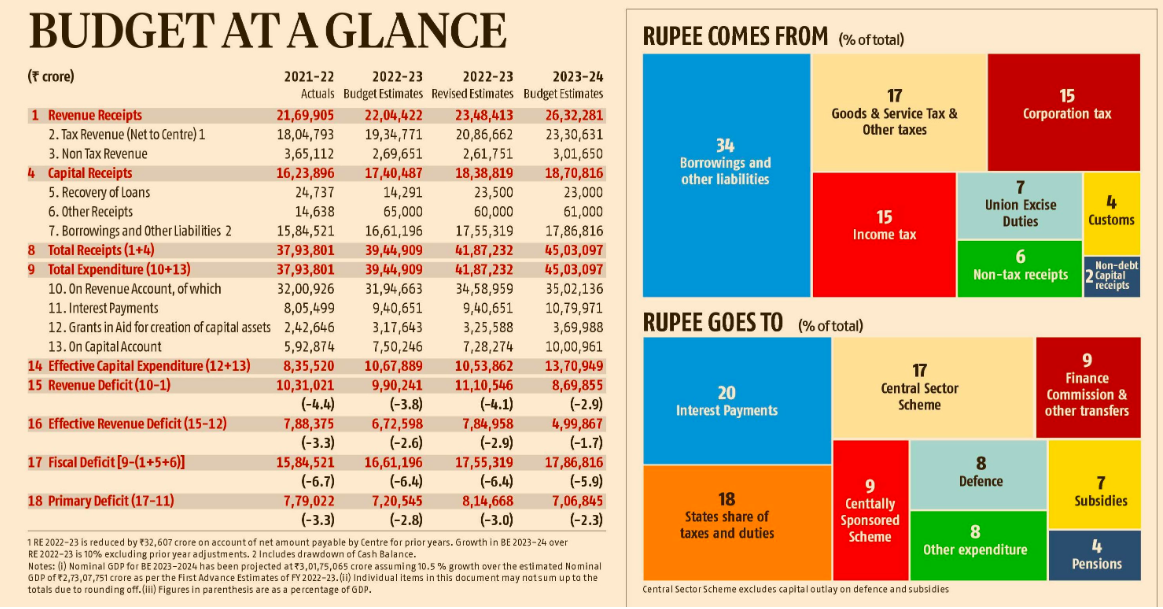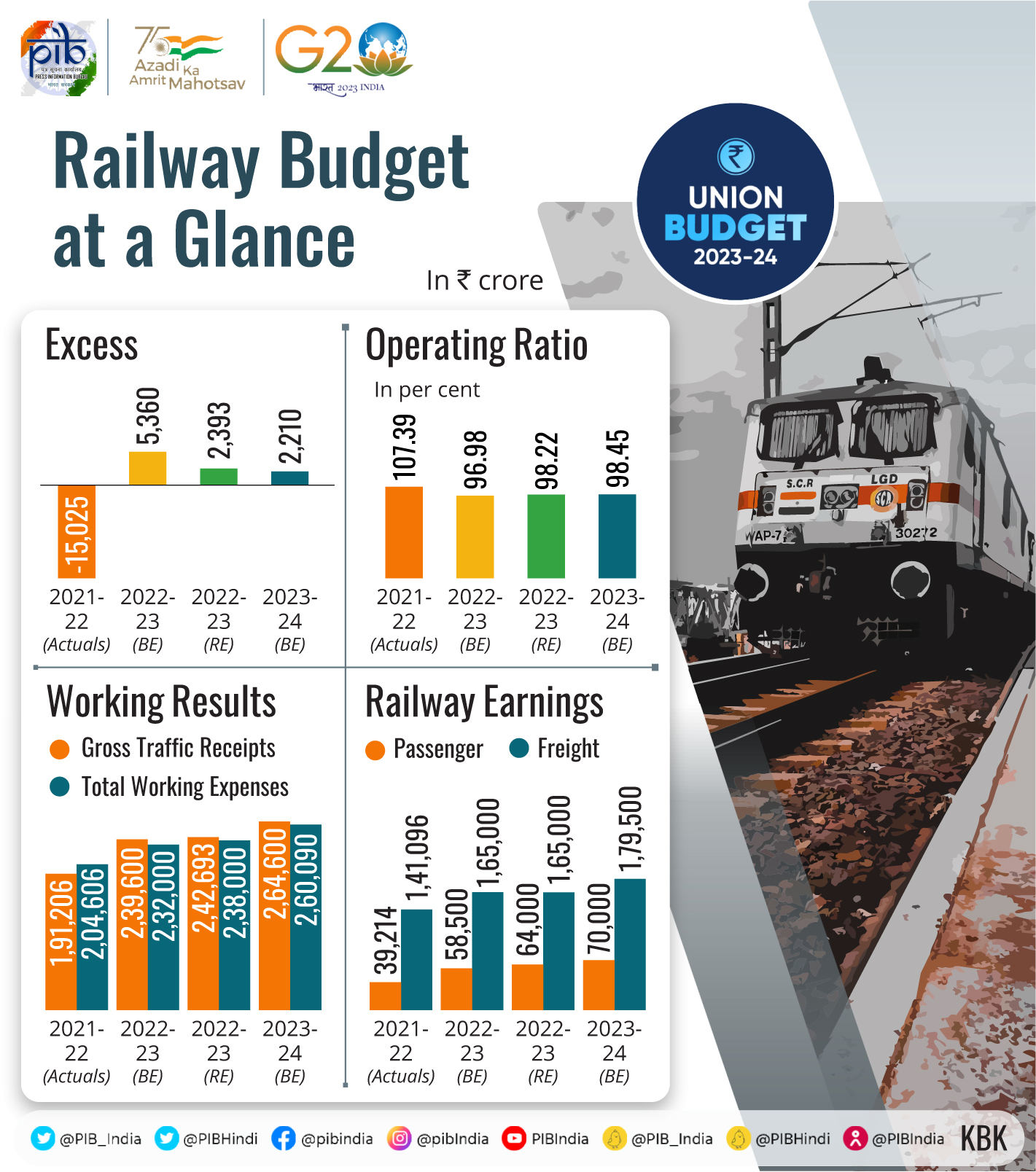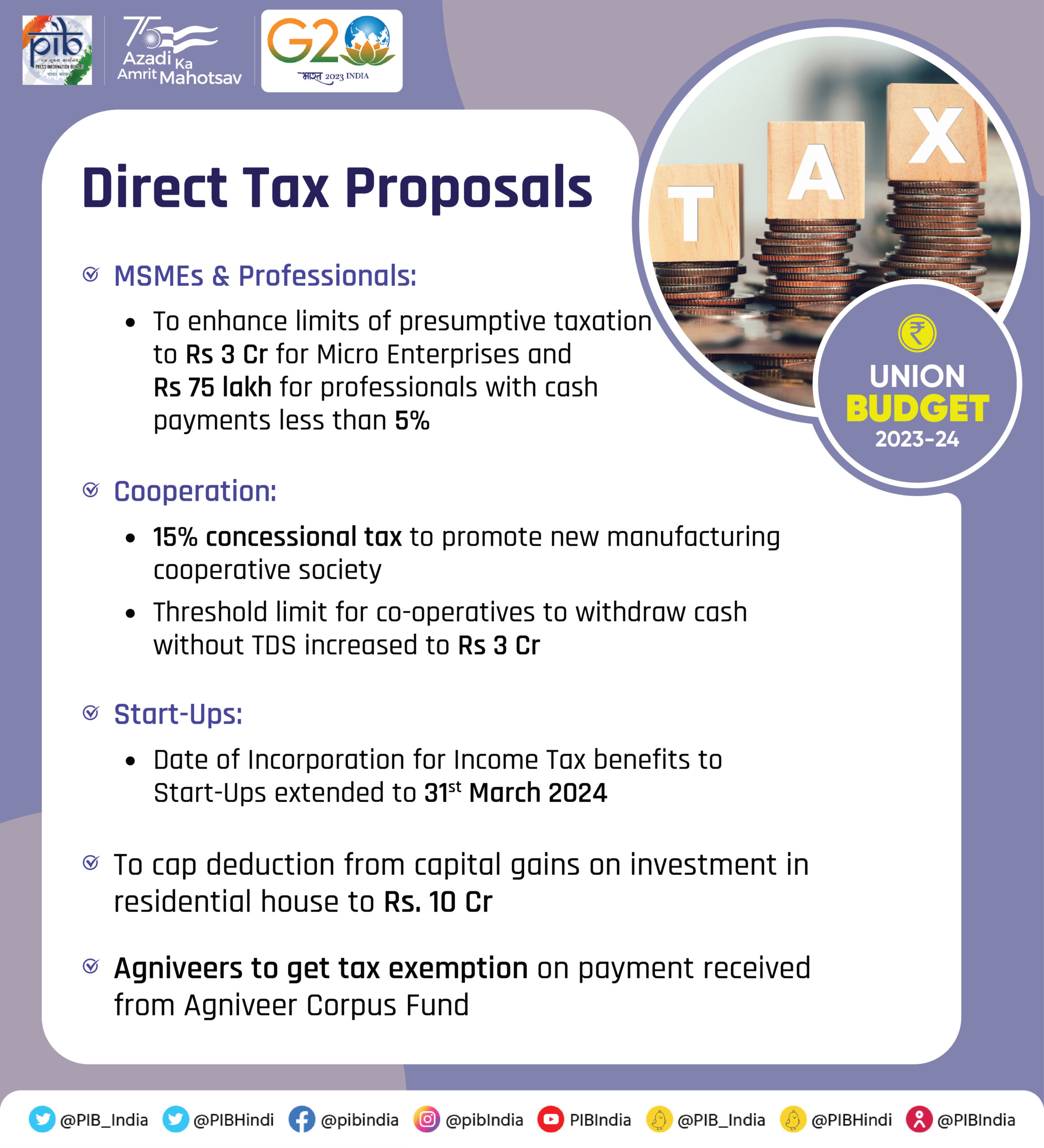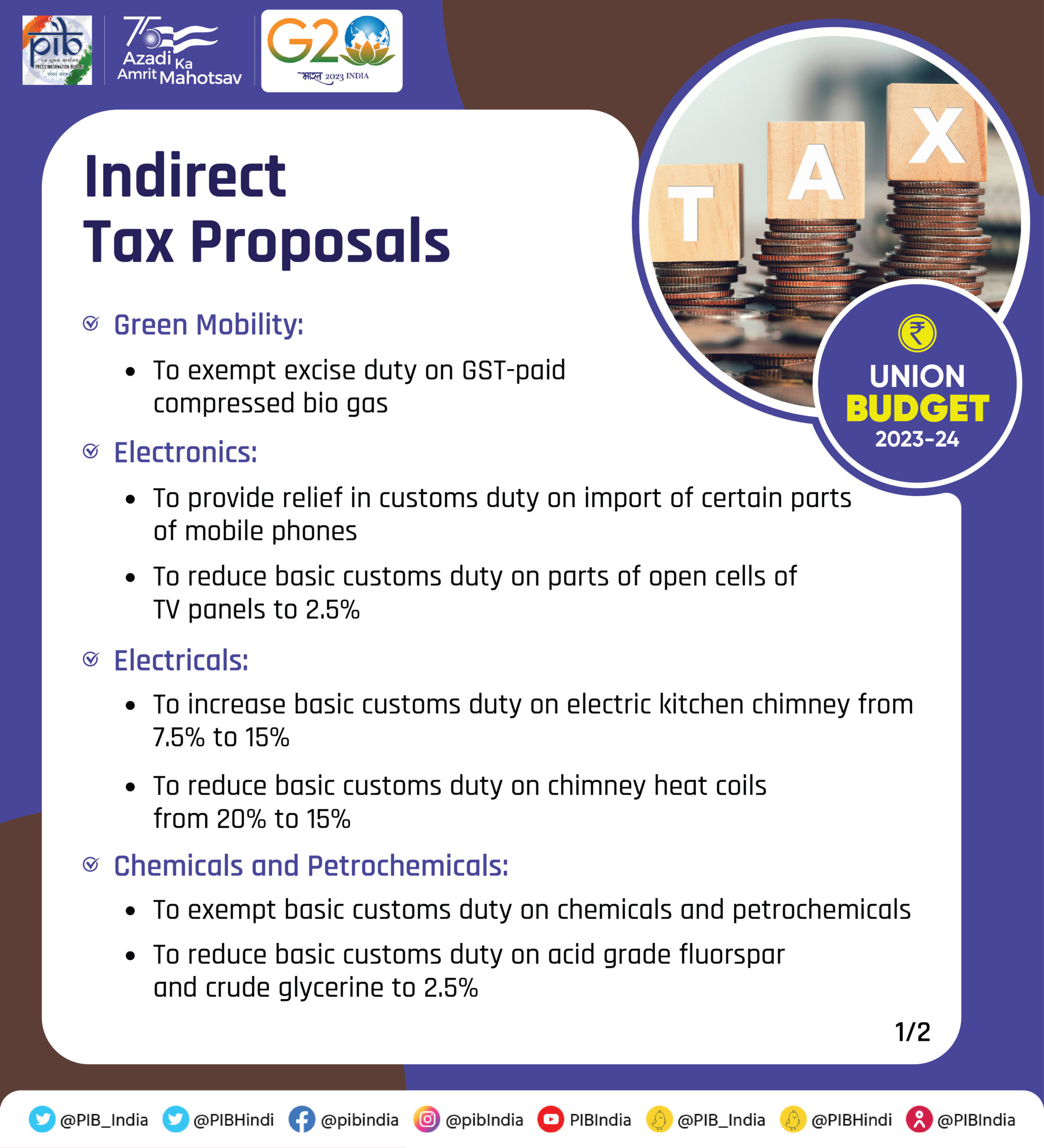ForumIAS announcing GS Foundation Program for UPSC CSE 2025-26 from 19 April. Click Here for more information.
Contents
- 1 Introduction
- 2 What is the vision of the Union Budget 2023-24?
- 3 What are the Priorities of the Union Budget 2023-24?
- 4 What is the break-up of Government’s Revenue and Expenditure?
- 5 What is the core strategy adopted by the Union Budget 2023-24?
- 6 What are the major highlights of UnionBudget 2023-24?
- 7 What are the Tax proposals mentioned in Union Budget 2023-24?
- 8 What are other significant proposals in the Union Budget 2023-24?
- 9 What are the concerns associated with the Union Budget 2023-24?
| For 7PM Editorial Archives click HERE → |
Introduction
The Union Finance Minister has presented the Union Budget 2023-24 in the Parliament. This is the last full budget before the next year’s General Elections. There were apprehensions that the Budget may resort to populist measures ahead of the election year. However, most economic experts have observed that the Government has tried to push for long term growth while ensuring macro-stability in the short term. The Government has focused on increasing the capital expenditure and raising more revenues through disinvestment and privatization. The Government has maintained fiscal prudence and has avoided splurging on populist schemes.
What is the vision of the Union Budget 2023-24?
The Union Finance Minister said that the vision for the Amrit Kaal includes technology-driven and knowledge-based economy with strong public finances, and a robust financial sector. To achieve this, Jan Bhagidari through Sabka Saath Sabka Prayas is essential. The Economic Agenda to achieve this focuses on 3 things: (a) Facilitating ample opportunities for citizens, especially the youth, to fulfill their aspirations; (b) Providing strong impetus to growth and job creation; (c) Strengthening macro-economic stability.
Source: PIB
To service these focus areas in the journey to India@100, Four opportunities can be transformative during Amrit Kaal, (a) Economic Empowerment of Women: Through formation of large producer enterprises or collectives; (b) PM ViIshwakarma KAushal Samman (PM VIKAS): The art and handicraft created by traditional artisans represents the true spirit of Atmanirbhar Bharat. A package of assistance for them has been conceptualized to enable them to improve the quality, scale and reach of their products, integrating them with the MSME value chain. This will greatly benefit the SCs, STs, OBCs, women and people belonging to the weaker sections; (c) Tourism: The sector holds huge opportunities for jobs and entrepreneurship for youth in particular. Promotion of tourism will be taken up on mission mode, with active participation of States, convergence of Government programmes and public-private partnerships; (d) Green Growth: India is implementing many programmes for green fuel, energy, farming, mobility, buildings, and equipment, and policies for efficient use of energy across various economic sectors. These green growth efforts help in reducing carbon intensity of the economy and provides for large scale green job opportunities.
What are the Priorities of the Union Budget 2023-24?
The Union Finance Minister has listed seven priorities of the Union Budget and said that they complement each other and act as the ‘Saptarishi’ guiding us through the Amrit Kaal. They are: (a) Inclusive Development; (b) Reaching the Last Mile; (c) Infrastructure and Investment; (d) Unleashing the Potential; (e) Green Growth; (f) Youth Power; (g) Financial Sector.
Source: PIB
What is the break-up of Government’s Revenue and Expenditure?
Revenues: The break-up of Government’s Revenues are: (a) Corporation Tax: 15%; (b) Income Tax: 15%; (c) GST: 17%; (d) Union Excise Duties: 7%; (e) Non-Tax Receipts: 6%; (f) Customs: 4%; (g) Non-Debt Capital Receipts: 2%; (h) Borrowings (Loans etc): 34%.
Expenditure: The break-up of Government’s Expenditure are: (a) Interest Payments: 20%; (b) States’ Share of Taxes and Duties: 18%; (c) Central Sector Schemes: 17%; (d) Centrally Sponsored Schemes: 9%; (d) Finance Commission and Other Transfers: 9%; (e) Defence: 8%; (f) Subsidies: 7%; (g) Pensions: 4%; (h) Other Expenditure: 8%
Source: Business Standard
Source: PIB
What is the core strategy adopted by the Union Budget 2023-24?
The Union Finance Minister chose to stick to the growth strategy that she first unveiled in 2019 when she announced a historic corporate tax cut. This growth strategy had two prongs.
Raising Capital Expenditure: Capital expenditure is the money that is spent on building productive assets such as roads, bridges and ports etc. Capital Expenditure has a greater return to the economy. The Budget has raised capital expenditure by the Government to INR 10 lakh crore. This is more than double the INR 4.39 lakh crore of 2020-21.
Fiscal Prudence: The Union Finance Minister has assured that the fiscal deficit will fall to 5.9% of the GDP. This is expected to have a salutary impact on the broader economy, as it suggests that money will be available for private entrepreneurs to borrow and invest.
| Read More: Fiscal Deficit in India: Trends and Concerns – Explained, pointwise |
What are the major highlights of UnionBudget 2023-24?
Fiscal Position: The Fiscal deficit target of 6.4% for FY2022-23 has been retained in the Revised Estimate for FY2022-23. The target for FY2023-24 has been reduced to 5.9% (INR 17.86 lakh crore). The medium-term target is to reduce Fiscal Deficit to 4.5% by FY2025-26.
Capital Expenditure (Capex): The Capital Expenditure has been hiked by 33% to INR 10 lakh crores (3.3% of GDP). The aim is to enhance growth potential and job creation, crowd-in private investments, and provide a cushion against anticipated global slowdown. The Effective Capital Expenditure is INR 13.7 lakh crore (includes provision made for creation of capital assets through Grants-in-Aid to States).
Railways: An outlay of INR 2.4 lakh crore provided for Railways in FY2023-24. It’s the highest ever highest ever allocation for Railways and is 9 times the amount allocated in FY2013-14.
Source: PIB
Defence Allocation: The allocation to defence sector has been hiked by 13%. Defence budget has increased to INR 5.94 lakh crore from last year’s INR 5.25 lakh crore. INR 1.62 lakh crore has been set aside for capital expenditure including purchases of new weapons, aircraft, warships and other military hardware.
MSMEs: Revamped credit guarantee for MSMEs will take effect from April 1, 2023 with infusion of INR 9,000 crore in corpus. The scheme would enable additional collateral-free guaranteed credit of INR 2 lakh crore and also reduce the cost of the credit by about 1%. An Entity DigiLocker will be set up for use by MSMEs, large business and charitable trusts for storing and sharing documents online securely, whenever needed, with various authorities, regulators, banks and other business entities.
Banking: The Government has mooted amendments to the Banking Regulation Act to improve governance in banks.
Employment: Pradhan Mantri Kaushal Vikas Yojana 4.0, will be launched to skill lakhs of youth within the next 3 years covering new age courses for Industry 4.0 like coding, AI, robotics, mechatronics, IOT, 3D printing, drones, and soft skills etc. 30 Skill India International Centres will be set up across different States to skill youth for international opportunities. Direct Benefit Transfer under a pan-India National Apprenticeship Promotion Scheme will be rolled out. A Promotion Scheme will be rolled out to provide stipend support to 47 lakh youth in three years.
Clean Energy: The Union Budget 2023-24 has provided INR 35,000 crore for priority capital investments towards energy transition and net zero objectives, and energy security. To steer the economy on the sustainable development path, Battery Energy Storage Systems with capacity of 4,000 MWH will be supported with Viability Gap Funding. National Green Hydrogen Mission with an outlay of INR 19,700 crore will facilitate the transition of the economy to low carbon intensity, reduce dependence on fossil fuel imports and enable India assume technology and market leadership.
Gems and Jewellery: To encourage the indigenous production of lab-grown diamonds, a research and development grant is to be provided to one of the IITs for 5 years. Basic customs duty on seeds used in the manufacture of Lab Grown Diamonds has also been reduced.
Aviation: 50 additional Airports, Heliports, Water Aerodromes, Advanced Landing Grounds will be revived to improve regional air connectivity.
Ease of Doing Business: The Government will bring another dispute resolution scheme Vivad Se Vishwas-2 to settle commercial disputes. PAN will be used as common identifier for all digital systems of Government agencies. One stop solution for reconciliation and updating identity maintained by various agencies will be established using digi locker and Aadhaar as foundational identity.
Central Processing Centre will be setup for faster response to companies through centralized handling of various forms filed with field offices under the Companies Act. Jan Vishwas Bill to amend 42 Central Acts have been introduced to further trust-based governance.
The Union Budget 2023-24 has announced multiple measures to enhance business activity in GIFT City.
Digital Services: Scope of services in DigiLocker will be expanded. 100 labs for developing applications to use 5G services will be set up in engineering institutions.
Bharat Shared Repository of Inscriptions will be set up in a digital epigraphy museum, with digitization of one lakh ancient inscriptions in the first stage. iGOT Karmayogi, an integrated online training platform, has been launched to provide continuous learning opportunities for lakhs of government employees to upgrade their skills and facilitate people-centric approach.
Phase 3 of e-Courts projects will be launched with outlay of INR 7,000 crore
Urban Development: Urban Infrastructure Development Fund (UIDF) will be established through use of Priority Sector Lending shortfall, which will be managed by the National Housing Bank, and will be used by public agencies to create urban infrastructure in Tier 2 and Tier 3 cities.
Cities will be incentivised to improve creditworthiness for municipal bonds.
Under the NAMASTE (National Action Plan for Mechanised Sanitation Ecosystem) scheme, the Union government will endeavour to enable 100% mechanical desludging of septic tanks and sewers in all cities and towns.
Housing: Outlay for PM Awaas Yojana has been enhanced by 66% to over INR 79,000 crore. The Union Government will continue to provide 50-year interest-free loans to State Governments for one more year.
Tribal Welfare: Pradhan Mantri Primitive Vulnerable Tribal Group (PM PVTGS) mission is being launched to improve socio-economic condition on PM PVTGS. INR 15,000 crore will be spent over next three years for providing safe housing, sanitation, drinking water, and electricity to tribals.
Health: The Union Budget 2023-24 has announced an allocation of INR 89,155 crore for the Ministry of Health, which is just 3.43% higher than its FY2022-23 outlay of INR 86,200.65 crore.
A new programme for research in pharmaceuticals will be formulated and the industry will be encouraged to invest in research. A Mission to eliminate Sickle Cell Anaemia by 2047 will be launched, which will entail awareness creation, universal screening of 7 crore people in the age group of 0-40 years in affected tribal areas.
Education: 157 new nursing colleges will be established in colocation with the existing 157 medical colleges established since 2014. Eklavaya Model Residential Schools to be set up in the next 3 years. The Union Government will recruit 38,800 teachers and support staff for 740 schools serving 3.5 lakh tribal students.
National Digital Library will be set up for children and adolescents. States will be encouraged to set up physical libraries for children at panchayat and ward levels and provide infrastructure for accessing the National Digital Library resources.
Artificial Intelligence: Three Centres of Excellence for Artificial Intelligence to be set-up in top educational institutions to realise the vision of ‘Make AI in India and Make AI work for India‘.
Agriculture: An Agriculture Accelerator Fund will be set up to encourage agri-startups by young entrepreneurs.
A new sub-scheme of PM Matsya Sampada Yojana with targeted investment of INR 6,000 crore will be launched to further enable activities of fishermen, fish vendors, and micro/small enterprises, improve value chain efficiencies, and expand the market.
Digital Public Infrastructure for Agriculture will be built as an open source, open standard and inter operable public good to enable inclusive farmer centric solutions and support for growth of agri-tech industry and start-ups. Computerisation of 63,000 Primary Agricultural Credit Societies (PACS) with an investment of INR 2,516 crore has been initiated.
PM Programme for Restoration, Awareness, Nourishment and Amelioration of Mother Earth (PM-PRANAM) will be launched to incentivize States and Union Territories to promote alternative fertilizers and balanced use of chemical fertilizers. Over the next 3 years, one crore farmers will get assistance to adopt natural farming.
To make India a global hub for ‘Shree Anna’, the Indian Institute of Millet Research, Hyderabad will be supported as the Centre of Excellence for sharing best practices, research and technologies at the international level.
500 new ‘Waste to Wealth’ plants under GOBARdhan (Galvanizing Organic Bio-Agro Resources Dhan) scheme will be established for promoting circular economy at total investment of INR 10,000 crore.
5% compressed biogas mandate will be introduced for all organizations marketing natural and bio-gas.
Atmanirbhar Clean Plant Program with an outlay of INR 2200 crore will be launched to boost availability of disease-free, quality planting material for high value horticultural crops.
Source: PIB
Tourism: 50 tourist destinations will be selected through challenge mode to be developed as a whole package for domestic and international tourism. States will be encouraged to set a ‘Unity Mall‘ in State Capital or the most popular tourist destination in the State for the promotion and sale of ‘OneDistrict, One product‘ and GI products and other handicraft. Tourism infrastructure and amenities will be facilitated in border villages through the Vibrant Villages Programme.
What are the Tax proposals mentioned in Union Budget 2023-24?
Direct Taxes
To further improve tax payer services, it has been proposed to roll out a next-generation Common IT Return Form for tax payers’ convenience, along with plans to strengthen the grievance redressal mechanism.
Rebate limit of Personal Income Tax has been increased to INR 7 lakh from the current Rs. 5 lakh in the New Tax Regime (NTR). New Tax slabs have also been proposed under the NTR. Highest surcharge rate is proposed to be reduced from 37% to 25% in the NTR. This to further result in reduction of the maximum personal income tax rate to 39%. The NTR will be made the default tax regime. However, citizens will continue to have the option to avail the benefit of the Old Tax Regime.
TDS rate will be reduced from 30% to 20% on taxable portion of EPF withdrawal in non-PAN cases.
Agniveer Fund will be provided EEE status. The payment received from the Agniveer Corpus Fund by the Agniveers enrolled in Agnipath Scheme, 2022 are proposed to be exempt from taxes. (EEE stands for Exempt-Exempt-Exempt meaning part of income invested is exempted (not taxed), interest earned on investment is exempt and the investment at the time of withdrawal is exempt).
Source: PIB
Indirect Taxes
The number of basic customs duty rates on goods, other than textiles and agriculture, has been reduced to 13 from 21.
Excise duty has been exempted on GST-paid compressed bio-gas contained in blended compressed natural gas.
Customs Duty exemption on specified capital goods/machinery for manufacture of lithium-ion cell for use in battery of electrically operated vehicle (EVs) has been extended to March 2024.
Source: PIB
Legislative Changes in Customs Laws
Customs Tariff Act will be amended to clarify the intent and scope of provisions relating to Anti-Dumping Duty (ADD), Countervailing Duty (CVD), and Safeguard Measures.
The CGST Act will be amended to raise the minimum threshold of tax amount for launching prosecution under GST from INR One crore to Two crore. It will also decriminalise certain offences.
What are other significant proposals in the Union Budget 2023-24?
Aspirational Blocks Programme covering 500 blocks launched for saturation of essential government services across multiple domains such as health, nutrition, education, agriculture, water resources, financial inclusion, skill development, and basic infrastructure.
New Infrastructure Finance Secretariat will be established to enhance opportunities for private investment in infrastructure.
National Data Governance Policy will be brought out to unleash innovation and research by start-ups and academia.
Mangrove Initiative for Shoreline Habitats and Tangible Incomes, (MISHTI) will be taken up for mangrove plantation along the coastline and on salt pan lands, through convergence between MGNREGS, CAMPA Fund and other sources:
Green Credit Programme will be notified under the Environment (Protection) Act to incentivize and mobilize additional resources for environmentally sustainable and responsive actions.
Amrit Dharohar Scheme will be implemented over the next three years to encourage optimal use of wetlands, enhance bio-diversity, carbon stock, eco-tourism opportunities and income generation for local communities.
National Financial Information Registry will be set up to serve as the central repository of financial and ancillary information for facilitating efficient flow of credit, promoting financial inclusion, and fostering financial stability. A new legislative framework will be designed in consultation with RBI to govern this credit public infrastructure.
To commemorate Azadi Ka Amrit Mahotsav, a one-time new small savings scheme, Mahila Samman Savings Certificate will be launched. It will offer deposit facility upto INR 2 lakh in the name of women or girls for tenure of 2 years (up to March 2025) at fixed interest rate of 7.5%.
What are the concerns associated with the Union Budget 2023-24?
First, Economists observe that the Income Tax exemptions under the Old Tax Regime promoted savings, which support investments. The New Tax Regime’s push towards consumption may hurt India’s savings rate.
Second, the funds allocated to the Mahatma Gandhi National Rural Employment Guarantee Scheme (MGNREGS) have been slashed by ~32% for 2023-24 (INR 60,000 crore compared to the revised estimate of INR 89,400 crore for FY2022-23).
Third, As compared to FY22-23 when INR 3,200 crore was allocated to the Department of Health Research, the allocation has been reduced by 6.87%.
Fourth, Higher import taxes can have detrimental effects on the jewellery industry, including an increase in cases of corruption and smuggling.
Syllabus: GS III, Indian Economy.
Source: Indian Express, The Hindu, Business Standard, PIB

